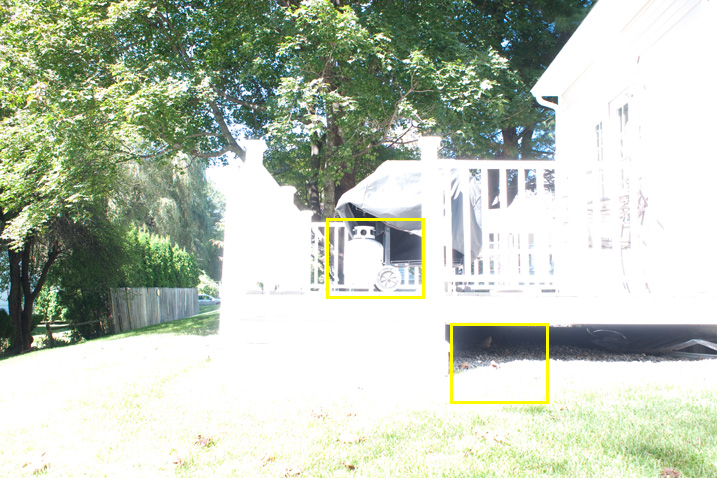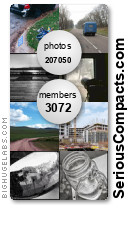In Part 3 of the shootout, we'll take a look at how the Sigma DP2 dynamic range compares to that of the Panasonic GH1 and M. Zuiko 17mm f/2.8.
Readers of this site may recall that the DP1 showed superior dynamic range in an earlier shootout, but the GH1 arguably features the latest and greatest Four Thirds sensor technology to date. How will they compare?
I chose a nearly impossible scene for the sake of comparison. At noon, without a cloud in the sky, there is probably no digital camera that can fully handle this dynamic range in a single exposure:

For comparison, we'll be looking specifically at the two regions highlighted by the yellow boxes above.
Test conditions:
- The GH1 was used in 3:2 aspect ratio.
- Subject distance was adjusted to match framing with the two systems.
- GH1 files were processed in Lightroom (latest version) and subsequently downsized using Photoshop Bicubic Sharper to match the native dimensions of the DP2 files.
- DP2 files were processed in Sigma Photo Pro (latest version).
- All settings were left on defaults. White balance was not adjusted to match colors, though I experimented with this and found that doing so did not substantially affect the results.
To begin with, a single RAW file was taken with each camera at ISO 100, f/5.6, and 1/50s.
Here are the crops without any exposure adjustments during RAW processing:

Clearly the DP2 is holding highlights better here. The black points are different, but you can actually see the shadow detail better in the DP2 file. This is evident in the stones under the deck (bottom panel).
Now let's see how much highlight detail can be recovered with a -2EV adjustment during RAW processing:

One possible explanation for the much greater highlight detail in the DP2 file is that what Sigma is calling ISO 100 corresponds to a lower actual ISO than what Panasonic is calling ISO 100. This would result in the DP2 file being underexposed relative to the GH1 file.
If that were the reason for the disparity, we would expect greater usable shadow detail in the GH1 file. Let's see what happens when the same files are pushed to +2EV during RAW conversion:

The greater shadow detail is now even more apparent in the DP2 file.
Conclusion: Under identical circumstances at base ISO, a DP1 RAW file simultaneously delivers greater highlight and greater shadow detail.
Next lets see how the two systems handle the same scene at ISO 400, f/11, 1/50s.
Here are the crops without any exposure adjustments during RAW processing:

The same files after a -2EV adjustment during RAW conversion:

Interesting that the ISO 400 DP2 file with a -2EV adjustment retains more highlight information than the ISO 100 DP2 file with a -2EV adjustment. We saw this in the DP1 shootout as well. It suggests that the high ISO DP files are being (partially or fully) pushed in SPP.
Now the same files after a +2EV adjustment during conversion:

Both files are struggling to produce any usable shadow information here. In the top panel, the DP2 still seems to do better.
The bottom line for ISO 400 is unchanged from the bottom line for ISO 100: better dynamic range from the Sigma.
The RAW files used in this comparison can be downloaded below:

